Similar Posts
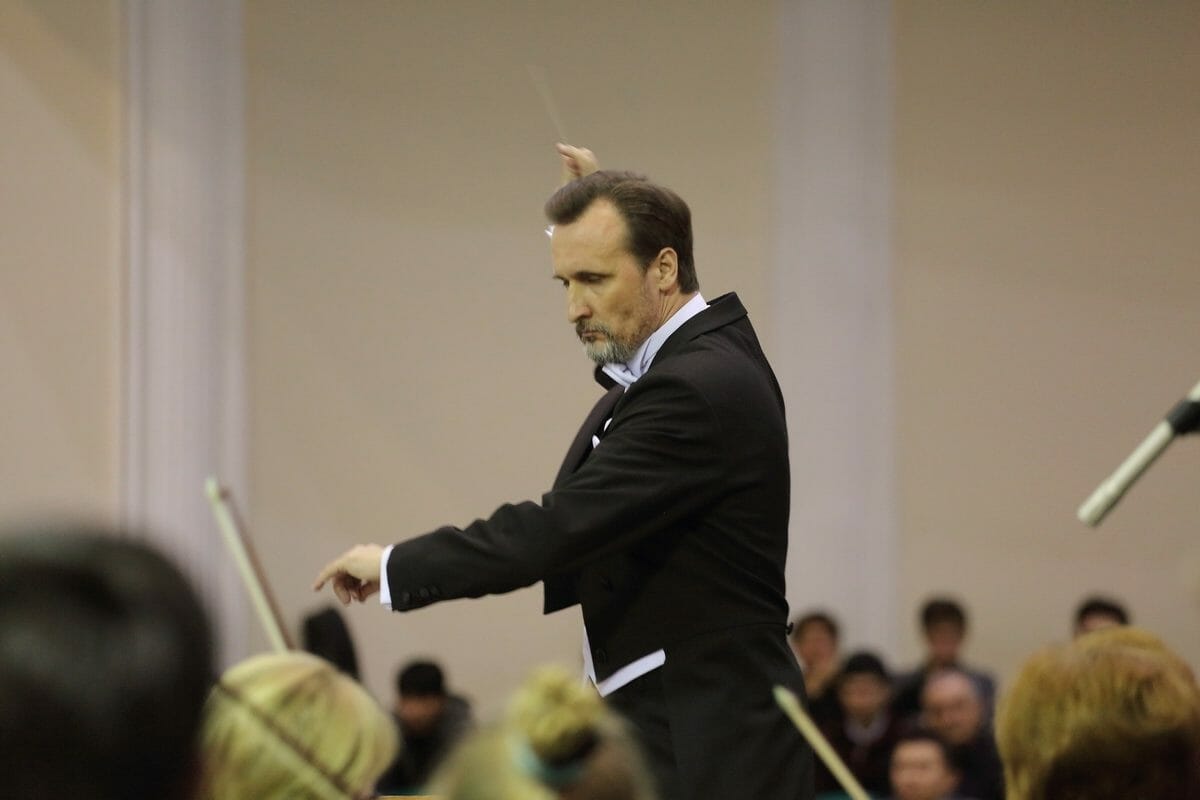
Concert on February 2, 2017. Vladimir Gorbik with the National Symphony Orchestra of Uzbekistan in the Great Hall of the State Conservatory of Uzbekistan. Photo: Yuri Rutka
(This interview with Russian conductor Vladimir Gorbik was first published in Pravoslavie i sovremennost, the official journal of the Diocese of Saratov, Russia)
As previously reported in the Orthodox Arts Journal, a new symphony orchestra has been established in Moscow under the direction of Vladimir Gorbik—chief choirmaster of the Holy Trinity-St. Sergius Representation (Podvorye) in Moscow, professor at the Moscow State Conservatory, and co-founder of the Patriarch Tikhon Russian-American Musical Institute in the United States.
Our conversation today is about the relationship between symphonic and sacred choral music. How is the conductor’s work affected, depending on whether he is working with a choir or an orchestra—what are the similarities and the differences? More importantly for readers of this publication, why is it valuable for Orthodox church musicians to be familiar with orchestral music?
NG: Mr. Gorbik, you are well known as a choirmaster and the conductor of several church choirs. At the same time, since your years at the conservatory, you have been engaged with symphonic music. How does a choral conductor’s expertise compare with that of a symphonic-operatic conductor?
VG: We can find precedents for this in the history of the performing arts. One of most vivid ones in the first half of the twentieth century was the conductor of the Bolshoi Theater in Moscow, Nikolai Golovanov, who was initially trained as a choirmaster at the Moscow Synodal School of Church Singing.
In my own case, the dream of conducting my own symphony orchestra was formulating in my heart from the time I was thirteen or fourteen. And, thanks be to God, it finally came to pass. I believe the opportunities that were given to me by Archimandrite [now Metropolitan] Longin to work with the choir at the Moscow Podvorye[1] became a kind of spiritual foundation for this. That is to say, I received my professional and technical foundation at the conservatory, while the spiritual foundation I acquired at the Podvorye.
At one time, some of my fellow conservatory graduates would say to me: “What? You’re going to work at a church? Are you crazy? Being a church choirmaster is a sure way to kill your career….”
My response was: “We do everything on a very high level there. Bishop Longin is very well versed in music, and not only church music, but also symphonic and operatic music. I even find myself constantly asking him for guidance.”
They were surprised at this, but smiled condescendingly, since they clearly didn’t get it.
These two musical spheres—the choral and orchestral—have intersected in my life constantly. Take, for example, a work such as Alexander Kastalsky’s “Great doxology,” which we sing at the Podvorye. It’s a choral piece, but it has symphonic elements in it. Generally speaking, what is the main difference between symphonic and choral thinking on the composer’s part? It lies in the magnitude of the musical forms. Symphonies are vast canvases, while choral works are, for the most part, miniatures. Although, of course, there are numerous exceptions. For example, the “Great doxology” and “Blessed Art Thou, O Lord” from Rachmaninoff’s All-Night Vigil are examples of choral canvases. But how did they come about? Because Rachmaninoff was a great symphonist, and he managed to combine these two realms in his work.
Therefore, in answering the question whether it’s possible to combine these two spheres, I simply mention the experience of our great predecessors. There are many names that come to mind: J. S. Bach, Beethoven, Mozart; and among Russian composers—Tchaikovsky, Rachmaninoff, and others. All these composers were able to express their creativity both chorally and orchestrally, and these two realms interact very closely in their works.
NG: One of our previous conversations was devoted to sacred music and the particular aspects of the choral conductor’s art. We mentioned that in the performance of sacred music the word is primary. But how does the conductor “read the text” of a symphonic work?
VG: Indeed, symphonic music is music in its pure form, without words. But, as the Scripture tells us: “In the beginning was the Word” (John 1:1). All meanings are born through words, including those of symphonic music. Let’s say a composer undertakes to write a symphonic work, an instrumental concerto, for exampe. A certain idea is born in his heart: what kind of music should this be? What do I want to express in this concerto? What feelings? As the creative process unfolds, the person converses with his soul, communicating with his own heart. This communication is made possible through the word. Ultimately, his ideas end up being expressed solely by means sounds. The orchestra plays, and the listeners receive “information,” as it were, through the various means of musical expression—pitch, timbre, rhythm, tempo, etc. That is, a unique language becomes apparent here—the language of music.
Here I’m simply repeating a thought expressed by others—that music is an amazing phenomenon, which can speak from one heart to another, from the composer to the listener, without any words. We know that just as music can inspire people to think about God and eternity, it can also cast the hearer down to hell, depending on what kind of music he is listening to. This is also a confirmation that music as a phenomenon is more emotional than rational, more heartfelt and soulful than those things that come from the mind. In this connection, I like to cite the great composer Aram Khachaturian (1903–1978), who would ask his students: “Do you weep when you write music? If not, then why are you doing it?”
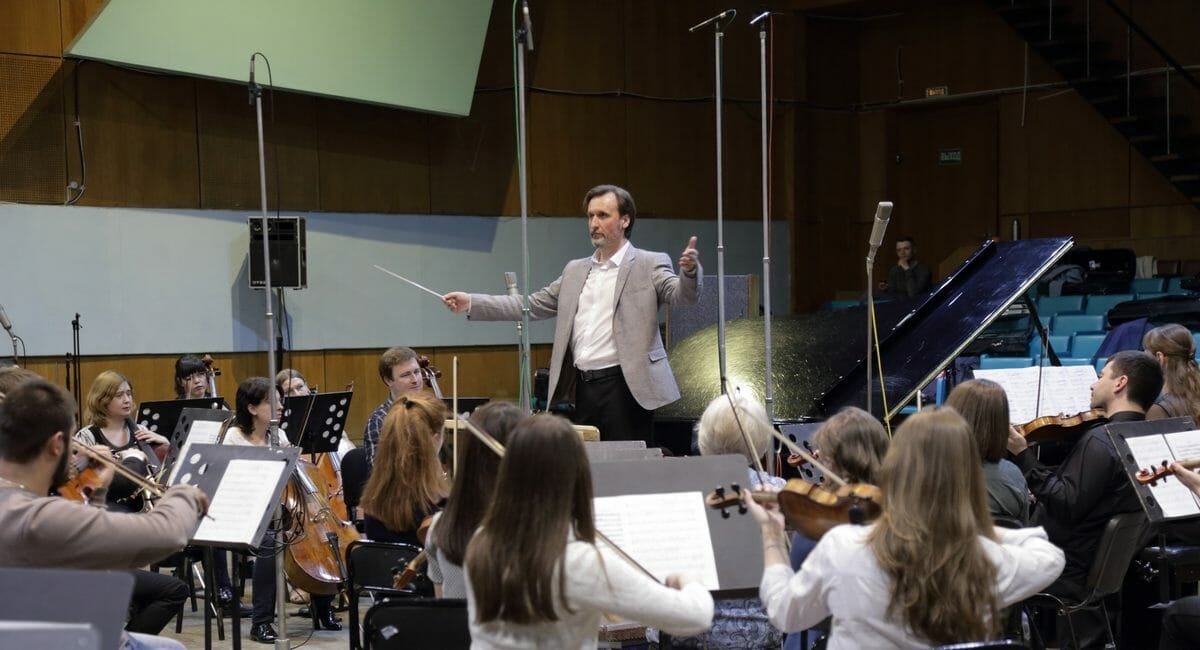
Rehearsal and recording of the Symphony Orchestra conducted by Vladimir Gorbik in the 5th studio of the State House of Broadcasting and Sound Recording (GDRZ) on May 15, 2017. Photo: Alexander Sokolov
Incidentally, when performing sacred music, if one wants to perform it in a truly prayerful, spiritual manner, one should not skip over the step we may call “soulfulness.” Bishop Longin explained this very clearly to us at the Podvorye. Speaking generally, when someone wants to build a spiritual relationship with another person, one simply has no right to lightly dismiss or bypass the stage of heartfelt emotional interaction. And with regard to music, this is even more the case. The bishop would say: “You may think you performed a given piece in a ‘spiritual’ manner, but in fact it will be sterile, antiseptic, and of no interest to anyone. All the performance markings may have been observed, and all the nuances executed, but it will have no soul.” This was a lesson learned for a lifetime. Any music, even if it happens to be identified as sacred, must first be “soulful,” and only then it becomes truly “sacred.”
Going back to your question… I would like to edit it slightly: How does a conductor perceive the depth of a piece of music? How does its potential inner meaning become clear to him? The conductor draws upon his experience—first of all, as a listener. Before undertaking the task of conducting, he has listened to a great deal of music! He has studied a lot of scores. He has worked out numerous figurative allusions. Suppose, a person undertakes to conduct Beethoven—he should have studied him well over the course of his career. He thus acquires, first of all, a significant amount of intuitive, implicit insight. At the same time, verbal insight is important here as well: the conductor may read scholarly articles—including those, for example, about how different conductors interpreted Beethoven, and so forth. In addition, every score contains a variety of interpretive markings, usually in Italian or German, placed there by the composer himself: designations of tempos (Allegro, Moderato, etc.), and other indications (for example, “calmly, gently” or “quickly, tempestuously”).
NG: The choral conductor works with live human voices, while the symphonic conductor works with an orchestra consisting of instruments. What are the fundamental differences and what are the commonalities?
VG: I would first like to address the commonalities. Any self-respecting music teacher teaches their instrument—be it the piano, the violin, the cello, or another instrument—drawing upon their ideas about the sound of a human voice. For example, my teacher Dilyara Sadykova in Tashkent, when I was just starting to take piano lessons, would teach me to “sing with my fingers.”
Incidentally, with regard to musical studies, recently, someone from the orchestra asked me an interesting question:
“Mr. Gorbik, what was your primary instrument?”
“I’ve played many instruments,” I replied.
They expressed surprise, and said, “But what was the very first one?”
At the age of six, I started playing the violin, then the cello, the piano, and afterwards, various wind instruments—alto saxhorn, trumpet, and percussion. Thus I tried to express my feelings in sound on different instruments, as a result of which I now have a large array of intuitive insights to draw upon when working with both an orchestra and a choir.
And here’s another interesting point: at the Moscow Synodal School of Church Singing [before 1917] the primary instrument taught to the choir boys was the violin, so that they would understand just (as opposed to tempered) intonation. This is because intonation on a violin resembles that of the human voice. The violin does not have frets, like a guitar, so one can move from pitch to pitch very gradually, just like the voice can. For this reason, any music teacher, and especially a string teacher, will draw the analogy to the human voice: “Play as if you are singing.”
And vice versa, if we were to speak here about choral singers, many of whom are not necessarily accomplished instrumentalists, but they also listen to instrumental music. So what can motivate a vocalist to grow technically? Believe me, nothing is more effective than hearing how a virtuoso instrumentalist plays their instrument. After all, voice is also an instrument. A number of years ago, in 1993, we accompanied Conservatory Professor Boris Lyashko to Germany for a performance of Sergei Taneyev’s cantata St. John of Damascus with the choir of the Cologne Musikhochschule. What particularly amazed me was that the singers in this choir handled their voices just like the virtuoso instrumentalists masterfully played their instruments. Sitting down at the piano during breaks between rehearsals, just for fun, they would sing technically complex passages from various arias in the high register, for example, from Mozart’s Magic Flute, so well and at such a fast tempo, that I was dumbfounded. Even at an ordinary student level, the singers of this choir had such command of their voices! Of course, this comes from a centuries-old tradition. In this connection, one has to mention Bach, whose music raised the choral and vocal performance in Europe to a very high level.
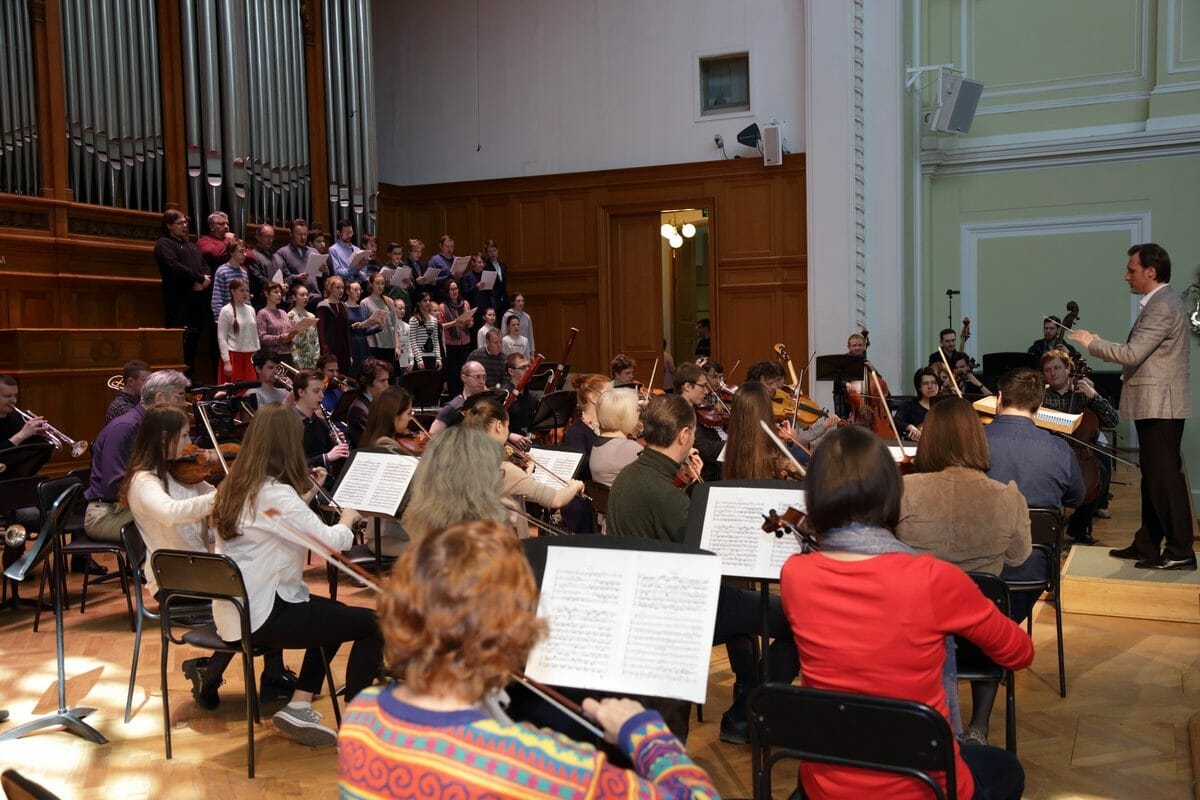
General rehearsal of the Symphony Orchestra conducted by Vladimir Gorbik and the Consolidated Choir of the Moscow Representation (Podvorye) of the Holy Trinity-St. Sergius Lavra before the concert on May 27, 2017, in the Great Hall of the Moscow Conservatory. Photo: Alexander Sokolov
Thus far, we’ve spoken about the commonalities. Now concerning the differences.
The voice, of course, is an instrument created by God himself, as I’m sure everyone understands. This, incidentally, is the reason why in the Orthodox Church only the human voice, as the most perfect among all instruments in the world, is used in divine worship. In this realm, however, everything needs to be understood in the proper interrelationship. One cannot argue that one is better, and the other—worse. People can serve God in many ways, including playing the violin. Exactly how they do this is something they alone comprehend; but as someone who is involved in both choral and symphonic music, I can attest to the fact that instrumentalists experience sublime feelings as they are playing. By contrast, I have also observed that a person who has a good voice and sings in a choir may not necessarily experience such feelings.
I would say that in working with a choir of voices, a conductor has a greater opportunity to express the idea and meaning of a work more clearly for a greater number of people. After all, in this instance the music is connected with the word. I happen to be thinking about the realm of sacred music, although there are also absolutely wonderful secular choral works, in which the connection of the word and music is great. Take a very simple example—the well-known song “Monotonously Rings the Coach-Bell.” Listening to this song, the listener is transported into a contemplative state, and the song begins to sound in his soul almost like a prayer, giving rise to the most luminous images. Through this song, one begins to commune with God. This is a very subtle moment.
On the other hand, a singer in a church choir, especially one who has just joined and may not be fully familiar with what is happening in the service, may not experience sublime feelings at all. He has a more mundane task—to hit the right notes.
Church choirs offer one more possibility—the potential to unite the hearts of those involved in singing. It is truly a sublime thing when a large choir sings a sacred piece “with one mouth and one heart.” Recently, during a recording project in Saratov,[2] forty-two remarkable singers came together from different parts of the world—Russia, America and Canada. When I gave the initial downbeat for Pavel Chesnokov’s “Great Doxology,” which we were singing during the Vigil service, I felt a breath that was truly universal in scope. One cannot describe in words what it’s like, when forty-two singers begin to praise God all together! In this regard, the choir has incredible possibilities.
In general, vocal music is simply more accessible to a greater number of people, whereas one has to acquire a taste for symphonic music. If someone has not been accustomed from childhood to listen to symphonic music, in adulthood it will be difficult do develop an appreciation for it. For this reason, in our family we try to acquaint our children with both symphonic and choral music literally from the time they are in diapers.
NG: How do the two realms—the choral and the symphonic—influence each other? What examples can you give from your point of view as a conductor?
VG: Our choir at the Holy Trinity-St. Sergius Podvorye is comprised of professional musicians who are laypeople, not monks. For a layperson to understand what prayer is they need to have traversed certain stages in the journey of life. At this point, not every singer in the choir is ready to accept explanations on a purely spiritual level. Therefore, I often need to employ the language of allegory, in order to give examples that everyone will understand.
Once we sang a concert in the Rachmaninoff Hall of the Moscow Conservatory, which was later to be produced as a CD. The program included the Sticheron after the 50th Psalm for the feast of St. Sergius of Radonezh, arranged by Archimandrite Matthew (Mormyl). Bishop Longin always tried to attend our rehearsals, but in this instance he heard this hymn at the concert for the first time, so afterwards he asked me to explain to him how we had managed to sing it so prayerfully. At the rehearsal, I had been practicing this piece with the guys, and I saw that it wasn’t working: their singing was dull and lackluster. And indeed, the notes here were quite simple, and the singers did not appear to be very challenged or inspired by them. The bishop had repeatedly warned me about this: professional musicians find it difficult to sing simple music. They do not see that it has anything special to offer them, just like a man who is accustomed to eating delicious gourmet food would find it difficult to be satisfied by simple porridge. Maybe this example is trivial, but it’s true. Their singing at the rehearsal was unacceptable, so I said: “Stop! All of us here have studied at the conservatory. How many people here know what an instrumental concerto is?”
Hands rose, indicating that everyone knew.
Then I asked: “Would you please imagine the middle movement of an instrumental concerto?” that is, music that is quiet, full of inner contemplation, and typically in a slow tempo, music filled with the most exalted feelings, which are already close to prayer.
“Think of a work from the classical repertoire that will remind you of the second, slow movement of an instrumental concerto, and use that as an image of how you are to sing this piece.”
The results were amazing! The singers took my comments to heart and began to sing in a manner that was profound—at once soulful and spiritual. Thus at the right moment, a connecting thread was found between the sacred and the secular, between choral and orchestral music.
Here’s another example. At a point in the final movement of Dmitry Bortniansky’s sacred choral concerto “Lord, Make Me to Know Mine End,” which is a fugue (on the words “Oh, spare me, that I may recover strength”—Ps. 38:13), the baritones and the second tenors come together in a musical culmination. But in this passage I was not getting enough power from the choir. So I said to them, “Guys, imagine how this might sound with trombones. Sing for me like trombones!” The effect was likewise transforming! They immediately began to sing in the proper manner. These are just some of the many examples that I have used with choristers from the realm of orchestral music.
Now let me describe the reverse process.
In November of 2016 and in February of 2017, I worked in Tashkent with two orchestras, the “Soloists of Uzbekistan” and the Uzbekistan National Symphony Orchestra. In the process, I noticed a very interesting thing: professional orchestra musicians are quite receptive to spiritual allusions.
Earlier, in September of 2016, I taught a master class in Australia, in which I worked with students of the Sydney Conservatory on the Symphony of Psalms by Igor Stravinsky and the Requiem of Gabriel Faure. The Dean of the conducting faculty, Professor Neil McEwan, who had invited me, asked me to tell the performers more about the spiritual side of these works. And while the Requiem is a form of Roman Catholic worship, I began to talk about it from the standpoint of the Orthodox worldview. The hall became “all ears,” as the saying goes; the students’ attentiveness was amazing! I was told later that, from that point on, the quality of the performance began to improve with every minute. That was how it appeared to someone who was observing from the outside.
At orchestral rehearsals, I constantly cite examples of how a human voice sounds.
Take the oboe, for example. This is one of my most favorite orchestral instruments: no other instrument sounds so “sweetly” (sladkoglasno—in the Church Slavonic sense of the word, literally “with a sweet voice”). It’s a timbre filled with a kind of visceral love, if one can say such a thing about an inanimate instrument. It is capable of eliciting the most touching and tender feelings in people. And this is something one needs to remind oboists of from time to time.
Or take the sound of the altos in the choir. When speaking to choral singers, one can say, “Add more chest register.” But the same comment is equally applicable to the violas in a symphony orchestra.
Or the timpani. Sometimes the timpani cover the whole orchestra with their sound. I remind them: “Imagine two surging cascades: one—an avalanche coming down the mountain, and the other—a mighty ocean wave. They are different by nature. The avalanche destroys everything in its way, while the wave fluidly goes around whatever obstacles it encounters. Never play forte (now I’m already speaking not only to the timpani, but to the entire orchestra) as if you are pummeling everything and everyone over the head with rocks. Forte, even fortissimo, must always be executed with a margin of reserve. ”
This very thought is something that Bishop Longin had instilled in my mind about the sound of the choir. He would say: “Never sing to the extreme. Always maintain the sense that you can add more sound. And when you have achieved that, you will have the proper forte.”
Absolutely the same thing can be said of the orchestra. When either the brass, or the percussion, or the strings predominate, unity is destroyed. Yet unity is a sonic expression of conciliarity, a sacrosanct feeling that—let’s admit it—is cherished by all people. It is feeling they experience when they perceive that they are part of a single whole, constituting, as it were, a single organism. As my orchestral conducting teacher, Professor Igor Dronov, used to say, “The orchestra is a kind of single mind—a single brain.” It is so interesting to note how these words so closely describe the way a choir should properly sing: “with one mouth and with one heart.”
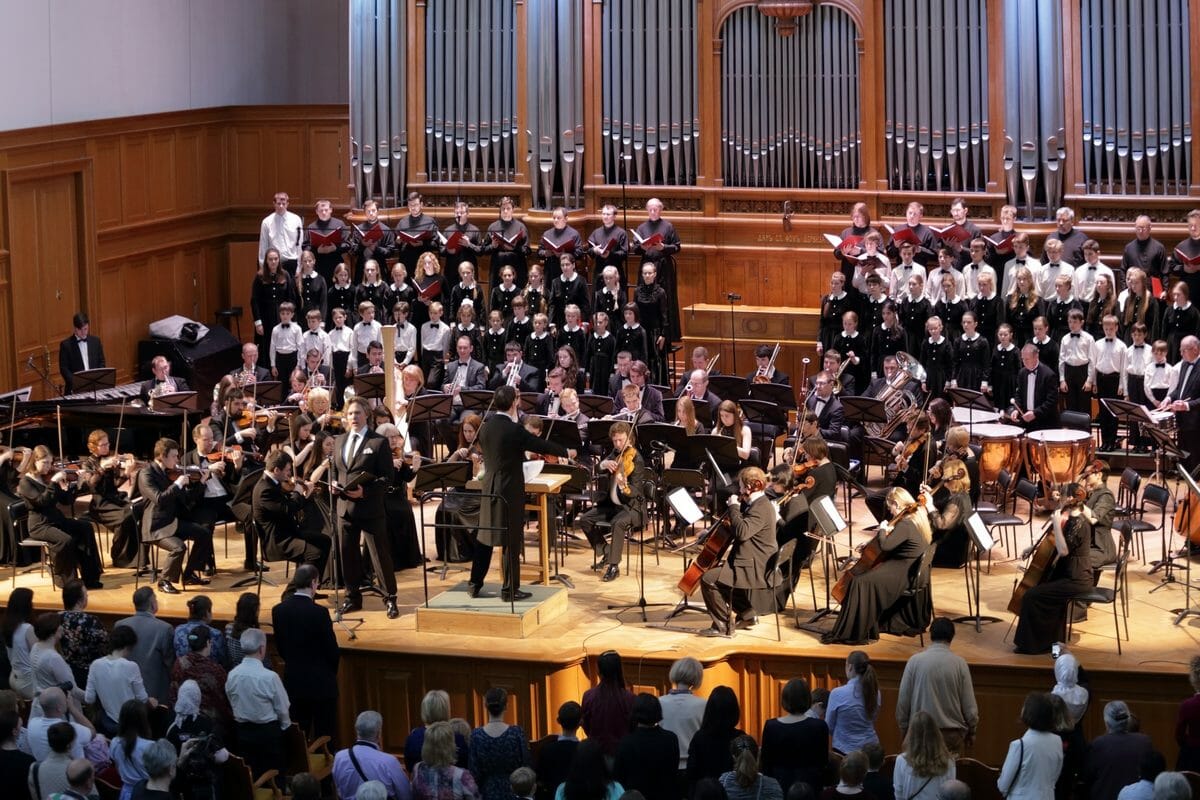
Concert May 27, 2017, of the Symphony Orchestra conducted by Vladimir Gorbik and the Consolidated Choir of the Moscow Representation of the Holy Trinity-St. Sergius Lavra in the Great Hall of the Moscow Conservatory. Photo: Alexander Sokolov
NG: Do you think that symphonic music is, by its essence, always a conversation of the human heart with God?
VG: Quite often, I think that is the case. Even the Elder Paisios of the Holy Mountain[3] would say that good classical music cries out to God and leads people to things on high.
To write music that will endure through the centuries, the composer must adopt for himself a certain ascetic framework. This may include the laws of harmony, or the laws of a particular genre. These are very complex. And in order to master these laws, one must possess faith. Faith is also needed in order to compose any work that is more or less significant, because it is the Lord Himself who, through people, creates all things that ultimately touch our hearts and call us to the sublime. Music can be heroic or it can be tragic. Take, for example, Tchaikovsky’s Sixth Symphony, or Bach’s B-minor Mass, or Mozart’s Requiem. Music can be filled with sorrow and repentance, or it can be filled with joy, light, and triumph. Many of these same feelings we also encounter in the spiritual music of the Orthodox Church.
NG: This is natural, because it is the life of the human soul.
VG: Yes, and symphonic music cannot bypass this life of the soul. It directly relates to that life.
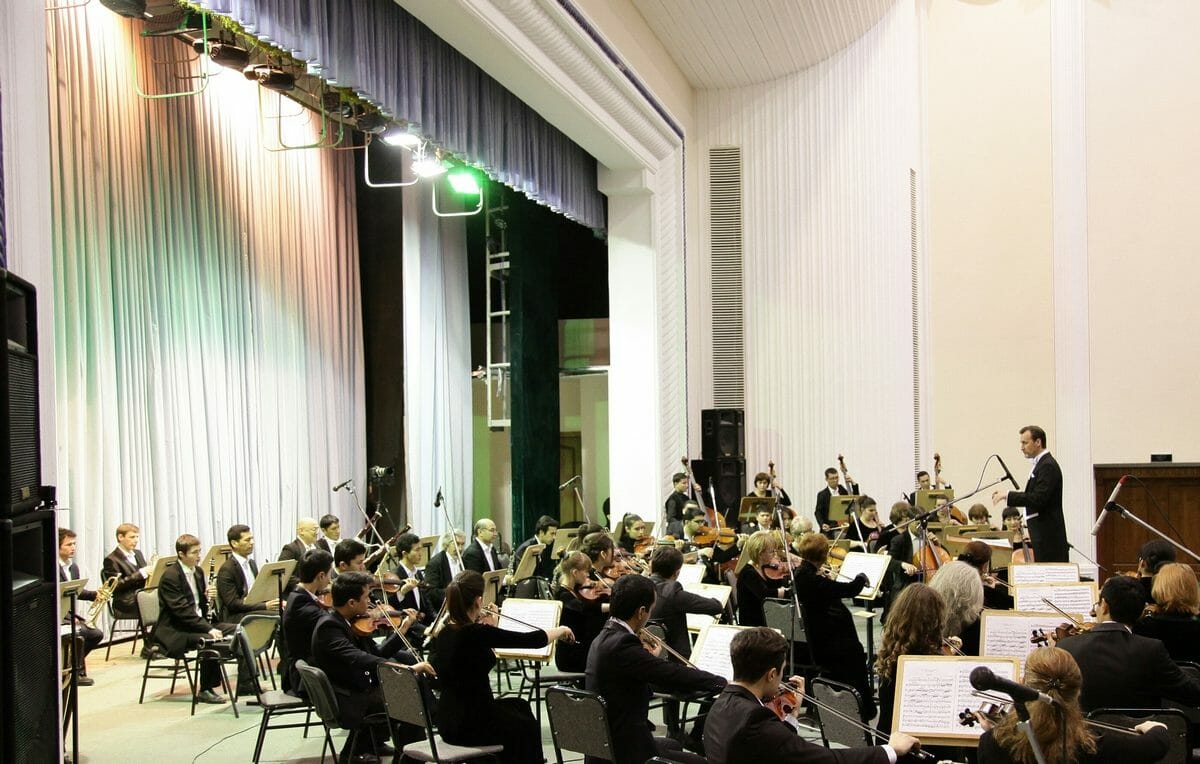
Concert on February 2, 2017, with the National Symphony Orchestra of Uzbekistan in the Great Hall of the Uzbekistan State Conservatory. Photo: Yuri Rutka
NG: Just now we touched upon the subject of asceticism in the work of a composer. Is the concept of asceticism applicable to the creative activity of a conductor as well?
VG: Absolutely! In any art there are certain canons. The conductor’s art is relatively young—just over two hundred years old, if we are speaking of the classical type of conducting, when the conductor stands with his back to the audience and faces the orchestra.
We see certain manifestations of asceticism, for example, in the work of Yevgeny Mravinsky.[4] No unnecessary movements, no “conducting for the public.” Everything is deeply thought through and is subordinated to expressing the feelings of the composer whose music the orchestra is performing, rather than those of the conductor. This is high art, an inner asceticism towards which every conductor should strive.
And then there is conducting of an entirely different character—what we might call “Romantic conducting.” I do not want to say that one is good, and the other is bad. They are just different. For example, I consider Yevgeny Svetlanov[5] as one of the representatives of Romantic conducting, whereby the conductor incorporates into his gestures the information that he wants to communicate to the musicians, and then expresses it through a particular set of eloquent movements of the hands and the entire body. Here, incidentally we can make a comparison with iconography. We know that there is Byzantine iconography, and there is iconography of later times. The Byzantine style is distinguished by its asceticism and the absence of excess; the later style is characterized by its expanded scope, the more vivid use of color, and the greater presence of decorative elements, in the good sense of that term.
For me, the apogee of the composer’s art is J. S. Bach, who is sometimes even referred to as the “father of music,” whereas the summit of the conducting art, among Western European conductors, is Herbert von Karajan. I would call him “the father of conductors.” Because here was a man who, like Bach, managed to absorb the conducting experience of his predecessors and developed a new approach that combined both asceticism and the Romantic approach to conducting. He found that elusive golden mean. Undoubtedly, Vladimir Fedoseyev[6] and Yevgeny Svetlanov also belong in this category.
Let me mention some pedagogical considerations. An aspiring conductor who is looking to express his feelings in a Romantic fashion, should think long and hard about ways of expressing them more modestly. While a person who wants to learn to conduct in an ascetic manner, in the spirit of Yevgeny Mravinsky, should remind himself: “I’m still young and not sufficiently experienced so as to be able to show everything in a few movements, as did Mravinsky. If I take this approach now, it will be evidence of my stiffness and lack of feeling.” We know this to be true in the realm of the spiritual life: if someone who is a novice declares that he had attained dispassion, he is in fact in a state of spiritual delusion (known as prelest). The same principles apply here: extremes come from the Evil One.
In my opinion, the conductor must choose the particular gestural language—the language of the hands, the language of facial expressions—in accordance with the specific music that he is performing. For example, it is very difficult to perform works of twentieth-century composers, especially Expressionists, using only restrained, ascetic movements. And vice versa: it is very difficult to perform Bach or his predecessors and contemporaries, using a Romantic approach to conducting—with a lot of flailing of the arms. It will look odd, to say the least. A conductor who does this is “posing for the audience,” trying to show people more than the music itself demands.
The same holds true for choral music. From the conductor’s point of view, there is no difference.
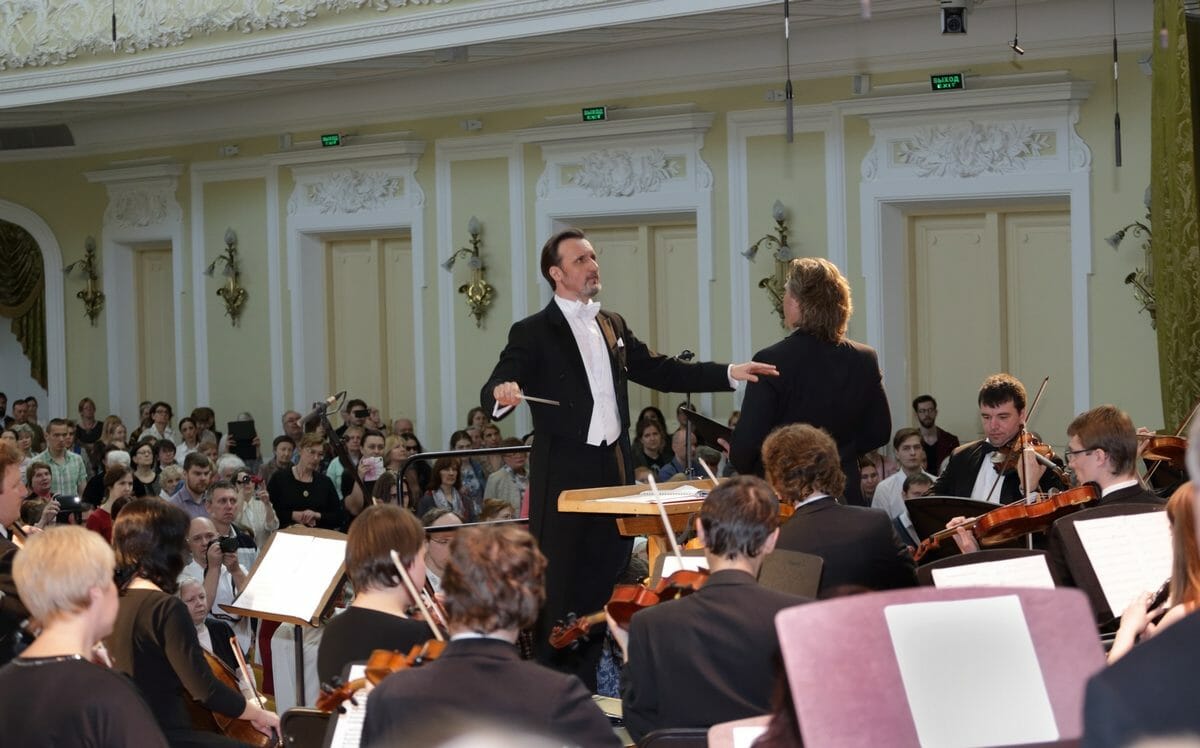
Concert May 27, 2017, Symphony Orchestra conducted by Vladimir Gorbik and the Consolidated Choir of the Moscow Representation of the Holy Trinity-St. Sergius Lavra in the Great Hall of the Moscow Conservatory. Photo: Alexander Sokolov
NG: In the end, how are music and faith interrelated?
VG: I would like to say that an Orthodox believer who is accustomed to the singing of an unaccompanied choir in church ought not regard orchestral symphonic music as something second-rate, which does not merit attention. Anyone who does this is simply wrong, in my opinion. This would be the same as if a person suddenly decided not to read fiction anymore, but to read only the holy Church Fathers. Not only does such an approach greatly limit a person, but it can also lead to an improper spiritual state. Yes, in some respects symphonic music can “ground” us, in the good sense of that word, with its emotional soulfulness. But this is a good thing, because the proper combination in the heart of the emotional and the spiritual yields very high results, whereas the absence of one of these elements can lead to undesirable consequences.
For this reason, I always advise those with whom I work as either a church choirmaster or a symphonic conductor: “You must listen to both choral and symphonic music, and you must learn to perform both kinds of music.” But you must to do this while believing in God. If you do all the very same things, but without faith, the results will be very different, and they will not be as interesting to people.
As a musician, I see that the realm of orchestral performance, interacting with the choral realm, makes the latter more professional, while at the same time acquiring a spiritual dimension. In my own practice I constantly experience the validation of this approach.
* * *
The debut of the orchestra under Vladimir Gorbik’s direction took place on May 27, 2017, in the Great Hall of the Moscow Conservatory, as part of the annual graduation concert of the Podvorye Choir School.
Vladimir Gorbik graduated from the Moscow Conservatory with specializations in choral conducting (Boris Tevlin’s class) and operatic-symphonic conducting (Igor Dronov’s class). Since 1995 he has been the choirmaster of the monastic brotherhood choir, then later, the professional male choir, and is also the artistic director of the choir school at the Podvorye. For a number of years he has successfully engaged in leading choral and orchestral ensembles in Russia, the United States, Canada, Australia, and Uzbekistan.
[1] Metropolitan Longin (Korchagin) of Saratov and Volsk was the Rector of the Moscow Representation (Podvorye) of the Holy Trinity-St. Sergius Monastery from 1992 to 2003.
[2] In July 2016, a combined Russian-American men’s choir, including singers from the Moscow Representation of the Holy Trinity-St. Sergius Monastery, the Choir of the Patriarch Tikhon Russian-American Musical Institute (PaTRAM), and the Hierarchal Choir of the Saratov Metropolia, recorded a CD of works by Pavel Chesnokov (1877–1944).
[3] A modern-day monastic ascetic and elder, St. Paisios of Mount Athos (1924–1994) is highly revered in Greece, Russia, and throughout the Orthodox Christian world.
[4] Russian conductor Yevgeny Mravinsky (1903 –1988) had a long, distinguished career at the Bolshoi Theater, the Kirov Ballet, and the Leningrad Philharmonic.
[5] Yevgeny Svetlanov (1928–2002) conducted at the Bolshoi Theatre and was principal conductor of the USSR State Symphony Orchestra (now the Russian State Symphony Orchestra). He also held conducting posts the London Symphony Orchestra., the Residentie Orchestra (The Hague), and the Swedish Radio Symphony Orchestra.
[6] Vladimir Fedoseyev (b. 1932) has been the long-time conductor of the Tchaikovsky Symphony Orchestra of the Moscow Radio.
Interview by Natalya Gorenok and translated into English by Vladimir Morosan.
